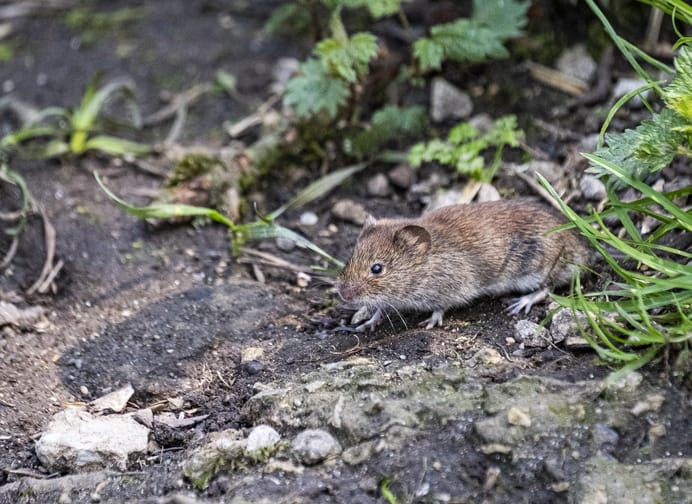Voles, also known as meadow mice, can cause significant damage to lawns, gardens, and landscaping. These minuscule rodents are known for their burrowing habits and voracious appetite for plant roots, and are liable to cause wreckage to your property in the process. Fortunately, there are ways to avoid a vole infestation from occurring by following certain steps. As most pest control experts would reiterate, preventing vole infestation is essential to protect your property from destructive behaviour.
Learn all about the effective strategies for vole control and prevention that will effectively work to protect your property during all seasons of the year.
Understanding Vole Behavior and Habits:
To effectively prevent vole infestation, it’s essential to understand their behaviour and habits. Voles are herbivores that primarily feed on grasses, roots, bulbs, and other vegetation. They create complex underground burrow systems for shelter and travel. Voles are most active during the spring and fall when food is plentiful. Understanding their patterns can help you identify and address potential vole infestation issues early on.
Maintain a Tidy Yard:
Keeping your yard tidy is a critical step in preventing vole infestation. Voles are attracted to areas with dense vegetation and clutter, as they provide ample hiding places and food sources. Regularly mow your lawn, trim shrubs and bushes, and remove debris, such as fallen leaves and branches. This reduces how compelling your property may be perceived to any small creatures eager for significant vegetation and wil effectively minimizes the potential habitat of voles.
Install Barriers and Fencing:
Physical barriers and fencing can be effective in preventing voles from accessing certain areas of your property. Use hardware cloth or mesh with small openings (less than an inch) to create barriers around vulnerable areas, such as gardens, flower beds, and tree bases. Bury the barriers at least six inches deep to deter voles from burrowing underneath. Fencing should be at least two feet high to prevent them from climbing over.
Remove Vole-Friendly Vegetation:
Voles are drawn to specific types of vegetation. Identify plants that are particularly attractive to voles, such as tall grasses, ground covers, and low-growing shrubs. Consider removing or relocating these plants away from structures or areas you want to protect. Replace them with vole-resistant varieties or plants that are less appealing to voles, reducing the likelihood of infestation.
Create a Clear Zone:
Creating a clear zone around structures and vulnerable areas can discourage voles from establishing burrows near your home or garden. Clear a strip of bare ground at least one to two feet wide around the perimeter of buildings, garden beds, and other high-risk areas. Voles prefer areas with vegetation cover, so maintaining a clear zone makes it less attractive for them to establish their burrows.
Minimize Water Sources:
Voles require a water source to survive. Minimizing accessible water sources can discourage them from inhabiting your property. Fix any leaking outdoor faucets, irrigation systems, or other water sources that may attract voles. Ensure proper drainage in your yard to prevent the accumulation of standing water, which can serve as a water source for these rodents.
Use Natural Repellents:
Natural repellents can be effective in deterring voles from your property. Some common natural repellents for voles include castor oil, garlic oil, and predator urine. Apply these repellents around vulnerable areas or on plants that are at risk of vole damage. However, it’s important to note that natural repellents may need to be reapplied periodically, especially after rain or irrigation.
Regularly Monitor and Inspect:
Regular monitoring and inspection of your property are essential for early detection of vole activity. Look for signs of vole damage, such as chewed plants, tunnels, and runways. Inspect the perimeter of your property and vulnerable areas to identify potential entry points or burrow systems. Early detection allows you to take prompt action to prevent vole infestation from spreading and causing further damage.
Implement Trapping and Removal:
If you notice signs of vole infestation despite your preventive measures, trapping and removal can be an effective methods to control the population. Place live traps or snap traps near vole burrows or along their runways. Use baits such as peanut butter, apple slices, or grains to attract voles. Check the traps regularly and remove captured voles from your property in accordance with local regulations.
Consider Natural Predators:
Introducing natural predators of voles can help control their population in a natural and environmentally friendly way. Owls, hawks, snakes, and domesticated cats are known to prey on voles. Encourage the presence of these predators in your area by providing suitable habitats or nesting boxes for owls and attracting birds of prey. If you have a cat, allow it supervised outdoor access to help deter voles from your property.
Seek Professional Assistance:
If vole infestation persists or becomes unmanageable, it may be necessary to seek professional assistance. Pest control experts or wildlife removal services have the knowledge and experience to handle vole infestations effectively. They can provide targeted solutions and advice tailored to your specific situation, ensuring the proper and humane removal of voles from your property.
Educate Yourself:
Continued education about vole control and prevention can further enhance your ability to prevent infestations. Stay informed about vole behaviour, the latest prevention techniques, and the most effective products available on the market. Local agricultural extension offices, gardening forums, and pest control websites are valuable resources for gaining knowledge and staying up-to-date with vole control practices.

Recent Comments